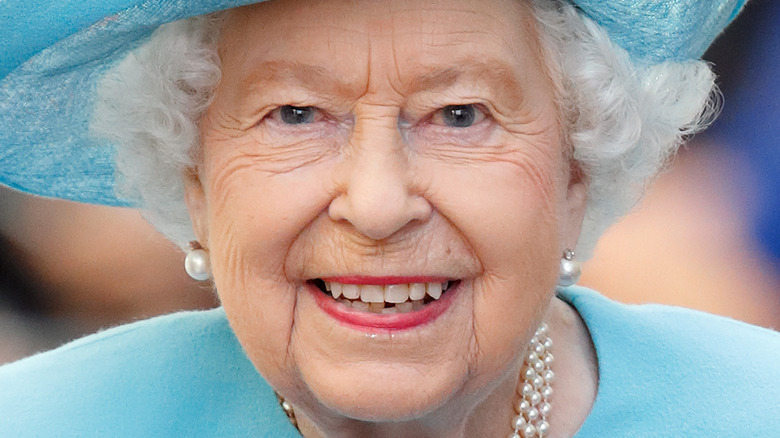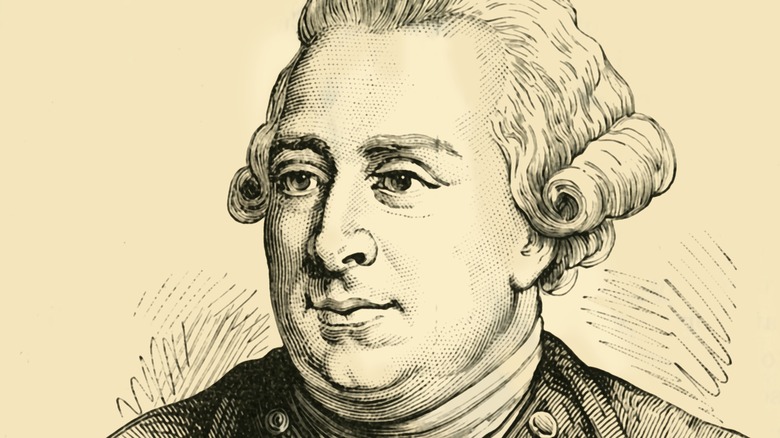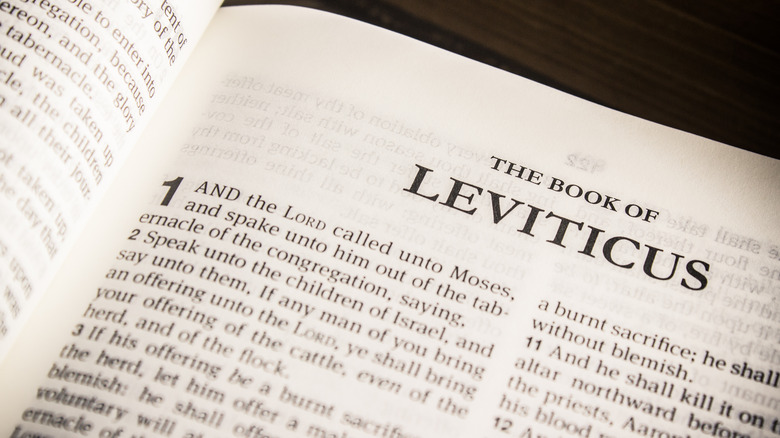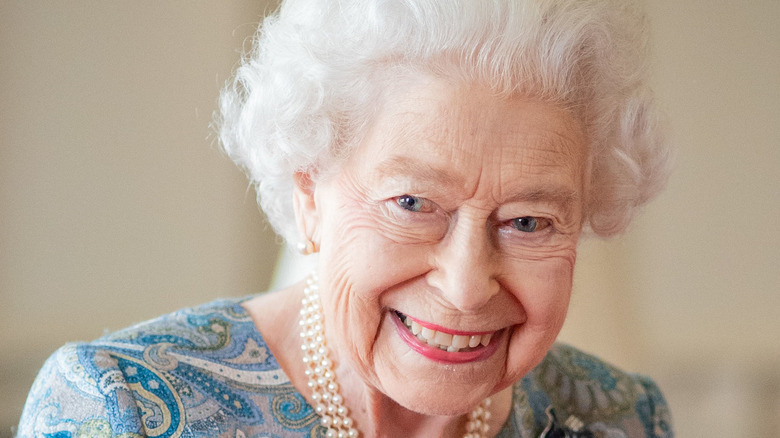The Unexpected Religious Origin Of Celebrating A Jubilee
On February 6, Queen Elizabeth II and the royal family will celebrate her Platinum Jubilee, or 70 years spent on the British throne. Defined by Merriam-Webster in this context, a jubilee is really any kind of special anniversary, but especially an anniversary marking 50 years. The longest-serving British queen before Elizabeth II was Queen Victoria, who celebrated Golden and Diamond Jubilees at the 50- and 60-year marks of her reign. Although Queen Elizabeth II is the first British monarch to ever reach 70, she and Victoria are certainly not the only British monarchs to celebrate their reign with a jubilee of some kind, per the official Royal website.
Given how common jubilees are in the British monarchy, jubilee celebrations are now most often associated with the lifespan of kings and queens. There's more to the tradition of jubilee celebrations than that, though. The real origin of a jubilee begins in the Old Testament, and the first people to observe jubilee-like celebrations were far from royalty.
The first British royal Jubilee
Before Queens Elizabeth and Victoria, the first formal royal jubilee took place in England in 1809, on the 50th anniversary of the reign of King George III (above), according to the Royal website. In 1935, George V — Elizabeth II's grandfather — also celebrated his Silver Jubilee (via History). At George III's Jubilee in 1809, there was a service among just family members at Windsor Castle, as well as a feast and fireworks display at Frogmore Cottage, an historic Windsor home (per The Week). Alongside other celebrations in England, London's Lord Mayor and his colleagues in government honored the king at St Paul's Cathedral and with a dinner at the mayor's residence, known as The Mansion House (via Visit London).
Born in 1926, Queen Elizabeth II likely remembers the Silver Jubilee of her grandfather, King George V, in 1935. She participated as a very young girl with her grandmother, according to the St. Paul's Cathedral website. One this occasion, a holiday was declared across England, with feasts, events, and other types of pageantry staged throughout May. History was also made with George V when he and the members of the royal family appeared in public at Buckingham palace. This proved so popular, a public appearance from the royal family has been part of jubilee celebrations ever since.
The Catholic origins of Jubilee
Although the true origins of jubilee celebrations stretch much farther back, there's precedent for jubilee years in the Catholic Church. Sometimes called Holy Years, Catholic tradition observes a jubilee every quarter century, or 25 years. It's believed that Pope Boniface VIII (pictured) was the first to declare a Holy Year in 1300, some three centuries before George III. Catholic tradition also says the pope may declare a Holy Year at his discretion. The last pope to do so was Pope John Paul II in 1983 on the 1,950th year since the death of Jesus. The last standard Holy Year was in 2000, as Reuters explains.
In observance of a jubilee year in the Catholic Church, amends should be made between those at odds with one another for any reason. Holy Year Jubilee celebrations should promote peace and solidarity, per Catholic tradition. So-called "Holy Doors" are opened in a Catholic jubilee year at St. Peter's Basilica in the Vatican, among a few other locations. In the Catholic faith, passing through a Holy Door symbolizes salvation and the remission of sin.
Jubilee and Hebrew Yovel
Jubilee can be traced much further back than Pope Boniface VIII in the year 1300, though. In Chapter 25 of the Old Testament book of Leviticus, God commanded those who belong to the House of Israel to observe Yovel every half-century. On these occasions, all agricultural work would cease, and all land must be returned to its rightful owner, particularly in instances when land was confiscated in lieu of debt repayment. Jewish indentured servants should also be freed with no outstanding debt, per How Stuff Works.
There's evidence that similar debt reconciliation holidays were observed across other ancient cultures in certain periods throughout history, including both the Babylonians and the Egyptians On that note, the modern Rolling Jubilee movement seeks to cancel specific kinds of debt carried by average people as a form of economic stimulus and humanitarian aid. This is very much in the spirit of ancient Hebrew Jubilee celebrations (via Debt Collective). That said, the connection between Yovel and the modern English word jubilee, though phonetically similar, is some disputed by some scholars, according to My Jewish Learning.
Yovel and the Shmita
There's further precedent in Judaism beyond Yovel, however. The 50-year cycle for Yovel could be related to the Jewish tradition of Shmita, or a sabbatical year taken on a seven-year cycle, appearing first in the Book of Exodus in the Old Testament. Relating primarily to agriculture, the Shmita tradition says land should only be worked for six years, then allowed to rest on the seventh. Even the idea of sabbath, or Shabbat, marking one day of rest, is based on this cycle of seven. Shmita also makes sense for practical reasons, in the worldview of ancient Hebrews.
In the time before modern agriculture and farming techniques, letting soil rest for a full 12 months in a Shmita year could greatly improve yield, per My Jewish Learning. Also part of Shmita, debts would be forgiven, with other forms of private property, including crops, redistributed for the public good. Referring to Shmita, the Book of Exodus said (via My Jewish Learning) "the needy of your people may eat, and what remains, the wildlife of the field shall eat. Do thus with your vineyard, with your olive grove."
Yovel and Shmita in modern Israel
In light of the Platinum Jubilee of Queen Elizabeth II, it's notable that no Yovel has been observed in Israel for 2,000 years — Yovel should extend to all Israel's inhabitants, and all 12 tribes have yet to return to their homeland, as My Jewish Learning explains. Conversely, Shmita years are still observed in Israel, as My Jewish Learning also notes. To accommodate the scale of modern food production, during Shmita agricultural landowners are now allowed to sell their property for just one year, among other exceptions, per the Jewish Telegraphic Agency.
In addition to being Queen Elizabeth II's Platinum Jubilee, 2022 — 5782 on the Jewish calendar — is also a Shmita Year, or Israel's 467th Shmita in history, according to Chabad. That puts Queen Elizabeth's 70-year anniversary celebration in a slightly different perspective, but an historic accomplishment, nonetheless. Beginning in February, the British monarch will hold celebrations through June, including feasts, parades, and the lighting of beacons (via Royal).





